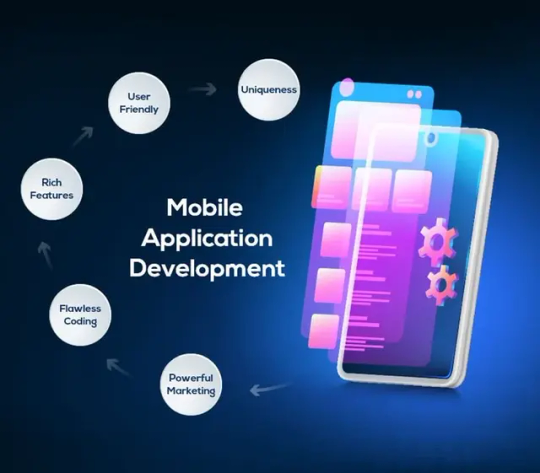Don't wanna be here? Send us removal request.
Text
The Art and Science of Game Development
Game development is a multifaceted and creative process that combines art, design, technology, and storytelling to create immersive and engaging experiences. As video games have become a dominant form of entertainment, the field of game development has grown significantly, encompassing everything from indie projects to massive AAA titles. Talmee Ltd, located in Manchester, is a leading Software company specializing in mobile app development, AI-driven solutions, and intuitive web design. the various stages involved, and the skills needed to create successful games.
The Essence of Game Development

Game development is the process of designing, creating, and producing video games. It involves multiple disciplines, including game design, programming, art and animation, sound design, and quality assurance (QA). Unlike traditional software development, game development focuses not only on functionality but also on creating an enjoyable and memorable experience for players. This requires a careful balance between technical precision and creative expression.
https://talmee.com/, apps development is about creating interactive experiences. Whether it's a fast-paced action game, a thought-provoking puzzle, or an expansive open-world adventure, the goal is to engage players in a way that captivates their imagination and emotions. This engagement is achieved through a combination of gameplay mechanics, visual aesthetics, narrative elements, and sound design.
Key Stages of Game Development
The process of developing a game typically follows several key stages, each requiring a unique set of skills and expertise.
Concept and Pre-Production:
Idea Generation: The development process begins with an idea or concept. This could be a new game mechanic, a story, or a specific aesthetic. During this stage, developers brainstorm and refine their ideas, considering what will make the game unique and appealing.
Research and Planning: Once the concept is solidified, the team conducts research to ensure the idea is feasible and marketable. They also create a detailed project plan, outlining the scope, timeline, budget, and resources required.
Game Design:
Design Document: The design phase involves creating a game design document (GDD) that outlines the game's mechanics, story, characters, levels, and overall structure. This document serves as a blueprint for the entire development process.
Prototyping: Developers create prototypes to test core gameplay mechanics and concepts. This allows the team to experiment with different ideas and identify potential issues before full-scale development begins.
Production:
Programming: During production, developers write the code that powers the game. This includes implementing gameplay mechanics, physics, artificial intelligence (AI), and user interfaces. Programming is the backbone of game development, turning ideas into interactive experiences.
Art and Animation: Artists and animators create the visual elements of the game, including characters, environments, textures, and animations. The art style is crucial in defining the game's aesthetic and overall feel.
Sound Design: Sound designers create the audio elements of the game, including music, sound effects, and voiceovers. Sound plays a vital role in immersing players in the game world and enhancing the emotional impact of the experience.
Level Design: Level designers craft the game's environments, challenges, and pacing. They ensure that levels are engaging, balanced, and aligned with the game's overall design.
Testing and Quality Assurance:
Playtesting: As the game nears completion, playtesting becomes crucial. QA testers play through the game to identify bugs, glitches, and other issues. They also provide feedback on gameplay, difficulty, and user experience.
Polishing: Based on feedback from playtesting, developers refine and polish the game. This involves fixing bugs, optimizing performance, and making final adjustments to ensure the game meets the desired quality standards.
Launch and Post-Release:
Marketing and Distribution: Once the game is ready, it is marketed and distributed through various platforms, such as Steam, consoles, or mobile app stores. Marketing strategies may include trailers, demos, social media campaigns, and press releases.
Post-Launch Support: After the game's release, developers may provide updates, patches, and downloadable content (DLC) to address issues and keep players engaged. Post-launch support is crucial for maintaining a game's longevity and success.
Skills Required in Game Development
Game development is a collaborative effort that requires a diverse range of skills:

Programming: Proficiency in programming languages like C++, C#, or Python is essential for implementing game mechanics, AI, and other technical aspects.
Art and Animation: Artists need skills in 2D or 3D art software, such as Adobe Photoshop, Blender, or Maya, to create characters, environments, and animations.
Game Design: A strong understanding of game mechanics, player psychology, and storytelling is crucial for designing engaging and fun experiences.
Sound Design: Knowledge of audio production software and techniques is important for creating music, sound effects, and voiceovers.
Problem-Solving: Game development often involves solving complex technical and creative challenges, requiring strong analytical and problem-solving skills.
Conclusion
Game development is a dynamic and interdisciplinary field that combines creativity, technology, and storytelling to create immersive experiences. From the initial concept to the final release, the development process involves multiple stages, each requiring specialized skills and collaboration. As the gaming industry continues to grow and evolve, the demand for innovative and engaging games will only increase, making game development an exciting and rewarding career path for those with a passion for both art and technology.
0 notes